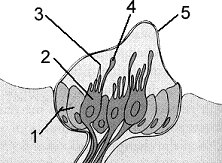In mammals, the filtrate leaves the blood by exiting from the ____
a. efferent arteriole
b. peritubular capillaries
c. renal artery
d. afferent arteriole
e. glomerulus
ANSWER: e
You might also like to view...
Engelmann's experiment demonstrated that ________
a. bacteria seek specific colors of light when cooled below certain temperatures b. plant cells produce different amounts of oxygen when illuminated by different colors of light c. green light is the most effective at promoting plant growth in greenhouses d. photosynthetic bacterial cells seek specific colors of light for optimum ATP production
Why are new flu vaccinations required for each new flu season?
A. The vaccination cannot contain enough preservatives to last in the body longer than a year. B. The flu virus can become latent, meaning it can hide from the immune system within the body, so new vaccinations are important to allow for continuing immunity. C. The vaccination does not contain enough antigens to create a lasting immune response, so boosters are required every year. D. The flu virus mutates frequently enough that last year's vaccination will no longer target currently circulating flu strains.
The sense organ in Figure 43-1 could be found in:

a. the semicircular canal of the human ear and in the lateral line organ of fish.
b. the cochlea of the human ear and the semicircular canal of the fish ear.
c. the semicircular canal of the human ear and the statocyst of invertebrates.
d. the utricle and saccule of the human ear and the statocyst of invertebrates.
e. the lateral line of fish and the statocyst of invertebrates
The nation-state is a(n):
A) independent entity whose territory consists of a city which is not administered as part of another local government. B) international actor having a ruling authority, citizens, and a territory with fixed borders. C) sovereign state which is viewed as comprising of two or more nations. D) sovereign state having a very small population or very small land area, but usually both.